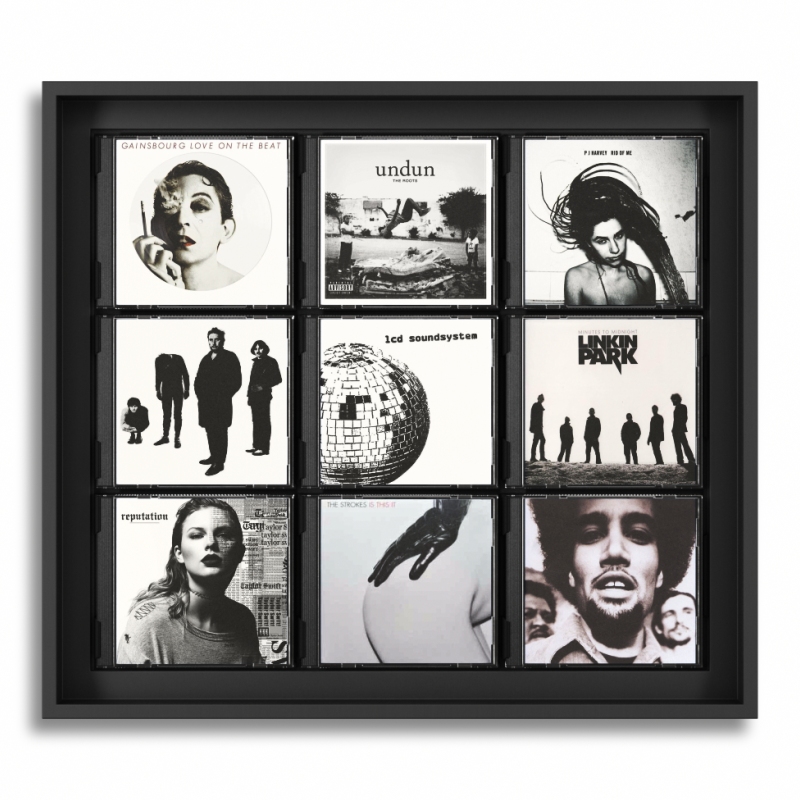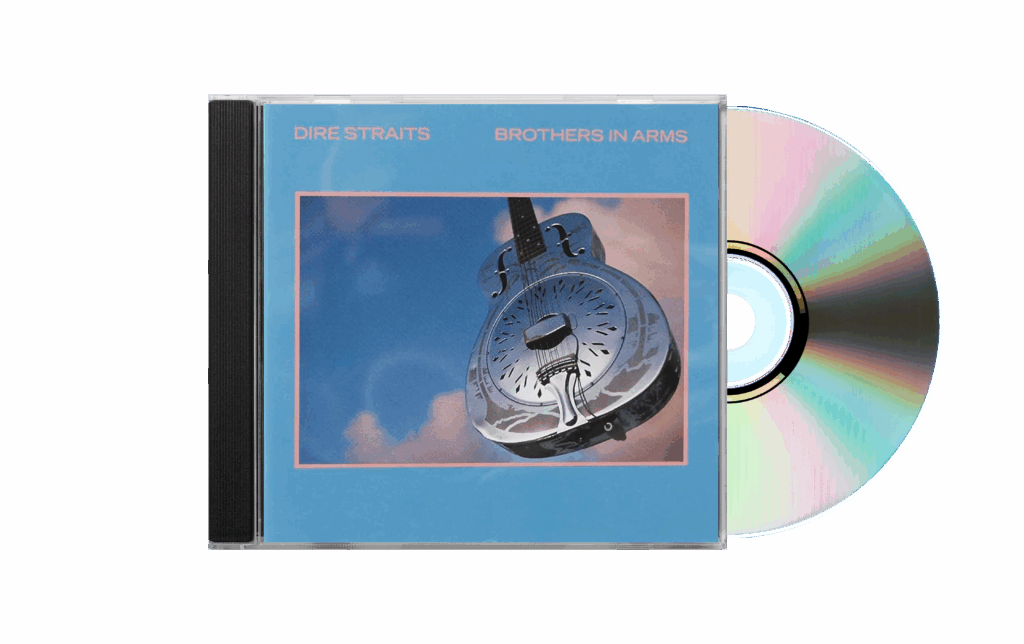The Story Behind Our CD Frames
When music meets design
Sometimes it’s enough to catch a glimpse of an album cover to be instantly transported to a life scene from the past.
That Radiohead CD that reminds us of those teenage evenings spent putting the world to rights…
That compilation that takes us back to that unforgettable road trip…
That jazz album discovered in our parents’ living room, which became our musical madeleine…
These memories crystallized in a simple 12 cm diameter object deserved better than anonymous storage.
They deserved to be celebrated, displayed, honored as the works of art they truly are.
A Tribute to Creators
Behind each album lies a fascinating creative universe.
The musicians, of course, but also the producers, sound engineers, graphic designers, photographers. All these artists who contributed to creating this complete work, both visual and auditory.
By framing a CD, we pay tribute to this collective creation. We celebrate not only the music, but also the meticulous work of the graphic designer who conceived the cover, the photographer who captured the essence of the album, the artistic director who orchestrated the whole.

Do you remember?
When we slipped the CD into the player and let ourselves be carried away by the musical journey the artist had imagined.
That progressive discovery of tracks, that surprise of falling in love with a song that wasn’t even the main single.
How many of our favorite pieces were hidden tracks, B-sides that we would never have discovered without that patient and complete listening?
And who has never spent long minutes browsing through an album booklet? Discovering the names of session musicians, recording studios, the artist’s touching acknowledgments? A dive into the behind-the-scenes of musical creation.
These little treasures of information transformed each album into an adventure, an exploration of a complete artistic universe.
Beyond the emotional aspect, we must recall a technical truth often forgotten:
the CD remains the most efficient musical medium in terms of audio quality. That exceptional sound fidelity that our contemporary ears, accustomed to compressed files, have almost forgotten.
Each CD we frame bears witness to this technical excellence, to this era when listening quality took precedence over storage convenience.
Music as a Way of Life
Today, faced with a generation accustomed to constant musical channel-hopping, we would like, through our CD frames, to transmit the art of taking time with music. To rediscover the pleasure of uninterrupted listening, without the reflex of compulsive “skipping.”
What if we educated our children in a way of listening to music that is more sensitive to artistic intention?
Our CD frames are not simple decorative objects.
They are the guardians of our musical memory, witnesses to our emotions, ambassadors of an era when music was savored differently.
Each frame we create carries this philosophy: to restore dignity to the musical object, transform our interiors into galleries of sonic memories, create bridges between generations around the shared love of music.
The Compact Disc
An object that revolutionized the music industry
The history of the CD begins in 1979. At that time, Philips and Sony formed a team of engineers tasked with working on a very specific project: designing a disc capable of storing music in digital format. A disc smaller than vinyl, less fragile and capable of capturing nuances that were previously imperceptible.
The first CD released to market was Billy Joel’s album “52nd Street” (originally released on vinyl in 1978). It became available on CD
on October 1, 1982 in Japan, coinciding with the release of the first CD player, Sony’s CDP-101.
Sales started slowly, but everything accelerated in 1985 when Dire Straits released their fifth album, Brothers in Arms. This record was the first album to be recorded entirely in digital format. It introduced the compact disc to the general public and became the first CD to sell more than one million copies.

The Story Behind Our CD Frames
When music meets design
Sometimes it’s enough to catch a glimpse of an album cover to be instantly transported to a life scene from the past.
That Radiohead CD that reminds us of those teenage evenings spent putting the world to rights…
That compilation that takes us back to that unforgettable road trip…
That jazz album discovered in our parents’ living room, which became our musical madeleine…
These memories crystallized in a simple 12 cm diameter object deserved better than anonymous storage.
They deserved to be celebrated, displayed, honored as the works of art they truly are.
A Tribute to Creators
Behind each album lies a fascinating creative universe.
The musicians, of course, but also the producers, sound engineers, graphic designers, photographers. All these artists who contributed to creating this complete work, both visual and auditory.
By framing a CD, we pay tribute to this collective creation. We celebrate not only the music, but also the meticulous work of the graphic designer who conceived the cover, the photographer who captured the essence of the album, the artistic director who orchestrated the whole.

Do you remember?
When we slipped the CD into the player and let ourselves be carried away by the musical journey the artist had imagined. That progressive discovery of tracks, that surprise of falling in love with a song that wasn’t even the main single. How many of our favorite pieces were hidden tracks, B-sides that we would never have discovered without that patient and complete listening?
And who has never spent long minutes browsing through an album booklet? Discovering the names of session musicians, recording studios, the artist’s touching acknowledgments? This intimacy with the work, this dive into the behind-the-scenes of musical creation.
These little treasures of information transformed each album into an adventure, an exploration of a complete artistic universe.
Beyond the emotional aspect, we must recall a technical truth often forgotten:
the CD remains the most efficient musical medium in terms of audio quality. That exceptional sound fidelity that our contemporary ears, accustomed to compressed files, have almost forgotten.
Each CD we frame bears witness to this technical excellence, to this era when listening quality took precedence over storage convenience.
Music as a Way of Life
Today, faced with a generation accustomed to constant musical channel-hopping, we would like, through our CD frames, to transmit the art of taking time with music. To rediscover the pleasure of uninterrupted listening, without the reflex of compulsive “skipping.”
What if we educated our children in a way of listening to music that is more sensitive to artistic intention?
Our CD frames are not simple decorative objects.
They are the guardians of our musical memory, witnesses to our emotions, ambassadors of an era when music was savored differently. Each frame we create carries this philosophy: to restore dignity to the musical object, transform our interiors into galleries of sonic memories, create bridges between generations around the shared love of music.
The Compact Disc
An object that revolutionized the music industry
The history of the CD begins in 1979. At that time, Philips and Sony formed a team of engineers tasked with working on a very specific project: designing a disc capable of storing music in digital format. A disc smaller than vinyl, less fragile and capable of capturing nuances that were previously imperceptible.
The first CD released to market was Billy Joel’s album “52nd Street” (originally released on vinyl in 1978). It became available on CD on October 1, 1982 in Japan, coinciding with the release of the first CD player, Sony’s CDP-101.
Sales started slowly, but everything accelerated in 1985 when Dire Straits released their fifth album, Brothers in Arms. This record was the first album to be recorded entirely in digital format. It introduced the compact disc to the general public and became the first CD to sell more than one million copies.

